A nuclear family is governed by a hierarchy. Two parents are in control. The children are governed and instructed by the parents. If parents are able to provide their family's needs of life and treat their children justly and fairly, it works. The nuclear family is systemically sound.
Nuclear families naturally emerge as the elements of a community. Unshackled by the restrictions of a modern State, human beings naturally gravitate into cohesive groups of 50 to 150 adults known as anthropological communities. These are small enough for everybody to know everybody else. The natural distribution of abilities among community members makes self government easy and natural with each contributing to the government of the community according to his ability, without the need for or tendency towards hierarchy.
I imagine early human communities as generally nomadic. So as long as there was enough land on the planet to allow communities adequate mean free space, then all would be well and peaceful. Or it could have been, were it not for humanity's statistical tendency to contain roughly a one percent of individuals with an inborn obsession to dominate and control their fellows. It is for this that human history unfolded into the cauldron of kingdoms and empires that are with us to this day.
The Advent of Hierarchy
The essence of a kingdom is hierarchy. This is because a king can personally know and thus get a handle on only 50 to 150 individuals. This is a natural constraint of the human mind that is probably a consequence of the physiology of the human brain. So for a kingdom of more than 150 adults, the king must delegate control to his 50 to 150 sub-peers to each rule over their 50 to 150 underlings.
Consider a median of 1:100 as the slope of the hierarchical pyramid. To rule over a million people, the king will thus require beneath him a 3-level hierarchy. Those who directly rule his people are therefore two levels removed from the presence of his court. He cannot therefore rule the people by counsel. He can only rule them through the blind ruthless enforcement of prescribed law.
And this is from whence disparity emerged. Members of the king's court are well rewarded. He knows them. They live abundantly. As one moves down his hierarchy of control, members of each successive level are still comfortable but decreasingly so. His subjects below the hierarchy survive under the burden of taxation that he forcibly imposes upon them to support his lifestyle and that of his governing hierarchy.
If he be a good king, he will tax his people frugally to acquire from them no more than the minimum necessary and sufficient revenue to maintain his reasonable lifestyle and sustain his government. If he be a bad king, he will tax his people to almost the threshold of insurrection to maintain a grandeurs lifestyle for himself, his government and his enforcers. In either case, his lifestyle and that of the members of his governing hierarchy are inevitably far more affluent than that of his subjects. Consequently, when he enacts laws to govern his people, they will be formulated within the context of his own lifestyle, which is a world away from the socio-economic context within which they are applied to his subjects. There is thus, as always, a total contextual disconnect between he who governs and he who is governed.
The Sham of Democracy
Modern sovereign states have populations two or even three orders of magnitude greater than the kingdom of a million people I have referred to above. Using the same hierarchical structure, that necessitates one or two extra levels of hierarchy. This removes the lowly subject or 'citizen' two more levels of control away from those that formulate and enforce the laws that govern them. On such a scale, monarchy as a system of government reaches absurdity. The governing of integral populations from 50 million to 1000 million has thus been entirely superseded by more devolved forms of government such as federations of states or confederations of republics. Furthermore, within these vast populations, the autocratic government of a king has supposedly been replaced by representative
democracy,
through which the people are deluded into thinking that they are governing themselves.
Notwithstanding, it is not the type of government that determines how any individual 'citizen' will fare under its rule. A caring king or a benign dictator governs his people with equity. An evil king or tyrannical dictator enslaves his people in misery. When each citizen of a democracy votes for policies that suit his own selfish ambitions, without concern for the catastrophic collateral effects those policies may have on some of his fellow citizens, then disparity will reign. For democracy to be fair and benign, each must vote for policies he truly believes will create conditions that are fair and satisfactory for everybody. But this is not the case. It can never be the case.
This is because, like the ancient king, those of affluence do not possess any context of understanding that would enable their selfish minds to see life through the eyes of their fellow citizens who are less fortunate. And 'fortunate' is the right word. Whether you fare well or badly within any form of human society is not determined by your effort or virtue. Neither is it determined by the laws of the land in which you live. It is determined by other laws: universal laws, which, unlike the laws of a king, cannot be disobeyed or broken. They are the Physical Laws of complex-dynamics.
It's an unfortunate error of language that the same word 'law' is used to denote both the laws of man and the laws of nature. They are not the same thing. They are totally different concepts. The laws of a king relate crime to punishment: the Laws of Physics relate cause to effect. Punishment is a pain, discomfort or deprivation, wilfully imposed by human hand, in response to an infraction of the law. Effect is an inevitable and immutable consequence of cause, which is mindlessly imposed by the universe.
A Complex-Dynamical Society
The quality of life and well-being of the individuals in a society are determined by the details of a comparatively simple protocol whereby those individuals interact with each other in ways such as: whether they exhibit good manners or are rude towards each other; whether they exchange things through fare trade or dishonesty; whether they willingly help a fellow in need or ignore his plight. This is what determines the group spirit. The interpersonal protocol is what determines the complex-dynamical behaviour of the society. It is independent of population. It is the driving force in the anthropological community of 100 adults. It is the driving force in a nation of 100 million people.
Human society is thus what is termed a 'complex-dynamical system'. The essence of a complex-dynamical system is that if you slice it into pieces, each piece has exactly the same structure and behaviour as the original whole. But you can only slice it down as far as its basic component, which may be such a thing as a molecule, an animal or a human being. A complex-dynamical system has no hierarchy. Its overall behaviour and form are determined by its millions of component parts all interacting with their immediate neighbours according to the system's simple protocol. Human society is a complex-dynamical system.
Complex overall effects of individuals following a simple protocol can be seen in vast systems such as the Earth's weather and ocean currents in which the participants are molecules of air and water. The same is true of smaller systems like the murmurations in flocks of starlings and shoals of fish. Also where the participants are the musical notes of a melody like Kate Bush's 'Wuthering Heights'. Yet all is effected by universal adherence to a simple benign protocol that governs the interactions between each pair of individuals.
For the rhythms of socialisation and trade to follow a benign behaviour, everybody must interact with his fellows according to a positive or benign protocol. This way, the whole society — no matter how large or small — will follow a benign attractor that will remain forever within the limits of behavioural excursion that will ensure its survival and prohibit catastrophic disintegration. The problem is that human nature, at its present stage of evolution, does not tend voluntarily to adhere to a benign protocol. It is for this reason alone that king or state needs to exist at this time.
To prevent the catastrophic disintegration of a large population, its king, through his hierarchy of government, tries to enforce a benign protocol upon his subjects through law. But a king is also subject to the negative aspects of human nature, which is reflected in his law. So the problem of human nature is resolved by forced subjugation of the people, allowing the negative human nature of only the king to have its way. And this is true whether the 'king' be an ancient exigent or a modern democratic majority.
The result is that vast minorities — and majorities of exploited third world countries — are today constrained to live in misery. This is, to my mind, unacceptable. Furthermore, as can be readily seen in current events, the socio-economies of the world are starting to fibrillate. Their convulsions loop ever closer to the envelope of catastrophe. Their self-imposed destruction is inevitable. The laws of man are not compatible with the natural laws of complex-dynamics. The laws of man are fighting the laws of nature. And in such a confrontation, the laws of nature are bound to win.
A Compatible Operating Method
It is thus vital to create and adopt a socio-economic system that is compatible with nature's laws of complex-dynamics. We need a way to work in harmony with them.
The essence of a kingdom — however small — is that the king has allodial possession of all land within his kingdom. He grants the economic use of it to 'whom he will' in return for tribute. And 'whom he will' are generally members of his family and court. Thus most have no land nor any direct right to use it for economic gain. So to get their needs of life, they must serve, which they can do only if someone who is 'landed' desires their service. Else they starve. The system is essentially the same under modern capitalism. Only the political wrapping has changed.
So the first necessity for creating a socio-economic system compatible with nature's laws of complex-dynamics is to return allodial possession of the Earth to everybody and establish the inalienable right of each to the unencumbered economic use of his fair share of its resources to turn his labour into his needs of life. This is what I have referred to as the landshare.
The second necessity is to remove all socio-economic constraints that today forcibly prevent human society from naturally crystallising into anthropological communities. In a community of a size in which everybody knows everybody else, misbehaviour is suppressed by natural social pressures and so state-enforced law is unnecessary.
The 'operating method' of a society that is compatible with the natural laws of complex-dynamics must embody the simple benign protocol by which its basic human components interact or relate with each other. It must facilitate each individual's relationship with his personal coterie of up to 150 other individuals and help him manage the application of his labour to his landshare in order to gain his needs of life.
I have given substance to this 'operating method' by writing it as a computer program 'fep.c'. The acronym 'fep' stands for 'fractal economy program'. A 'fractal' is the term for the basic component of a complex-dynamical system.
The program is written in the C programming language. On any Linux system, you should be able to run the ready-compiled version 'fep' from a terminal window, although you will probably need to give the downloaded executable file permission to run. However, if you compile the program from the source code, the resulting executable 'fep' will have been made executable automatically by the compiler.
The best way to proceed is to download the zipped version of the program and its data in the file fep.zip into a suitable folder of your choice. There, unzip the contents. Right-click on the 'fep' file and click on 'Properties'. The Properties dialogue box should open. Select the 'Permissions' tab. There, tick the box towards the bottom to make the file executable. Then close the Properties dialogue box. Alternatively, you can compile 'fep' from the source code in 'fep.c' using the command given near the top of the source listing in 'fep.c'. Open a terminal and change directory to the folder in which you downloaded the zip file. Copy and paste the compile command [that begins with gcc] into the terminal and hit 'Enter'. The resulting 'fep' file will have been already made executable by the compiler. Run the program by entering the command './fep' into the terminal and press 'Enter'. The program should open the window shown below under 'Tab 0: the PEOPLE Tab'.
If you get trouble from Internet service providers in downloading 'fep.zip' above, download instead fep2.zip, which excludes the executable. In this case, you will have to compile from the source code as described above.
A 'Fractal Economy' Program
The program has 8 separate functional areas, which are accommodated in the 8 tabs shown across the top of the window. The first deals with individual human beings — the fundamental components of a complex-dynamical human society. I have chosen one fictitious person. His name is Leonardo Araújo Pantoja. He lives on his landshare in a remote part of Brazil. He has a wife. She also has a landshare, which is contiguous with Leonardo's. They have two children. They too, by virtue of birth, each have their own landshares, which form a contiguous gleba of land with those of their parents. They produce their own food, assisted by intelligent machines that are designed specifically for easy small-scale production. However, they are not constrained to or imprisoned within their family gleba. They have means to travel far and wide as and when they wish.
Tab 0: the PEOPLE Tab
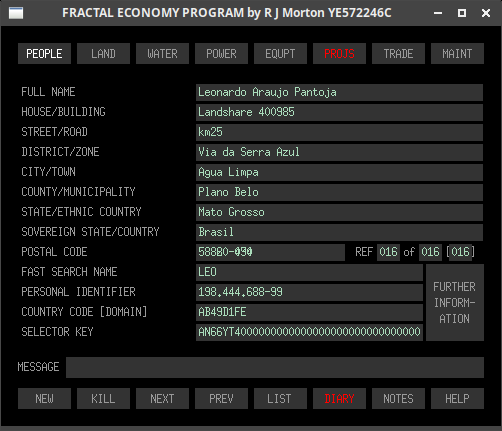
Each person Leonardo knows, including himself and his family, has a name and address record in his program's PEOPLE tab. The program is able to hold name and address [and other] information for up to 255 people. This limit is deliberate and intentional. Why? Because Leonado — like all of us — does not have the capacity to know more than about 150 people: the natural upper size limit of an anthropological community. Anybody beyond that is just a human life-form with a name or a number: but not a known person. The upper data limit of 255 records consequently includes a very generous contingency. It also discourages anybody from trying to apply the program to old-world style commerce.
The PEOPLE database thus contains Leonado's personal coterie of friends, family and colleagues that he knows and deals with. It will probably contain a very large proportion of people from his local home community. However, it will also contain people from afar: indeed from all over the world. As such, his coterie is individual to him. Although based on his own local community, it overlaps into many other local communities throughout the world. This is the nature of fractal connections in a stable and benign complex-dynamical human society.
The intention is that there should be a separate instance of the Fractal Economy Program [i.e. a separate data set] for each person. So Leonado's wife has her own FEP with her own coterie of contacts that is completely separate from Leonado's. This is because a person's relationship with each member of his or her coterie of friends, relatives and colleagues is systemically between two people. Of course, Leonado and his wife will have many coterie members in common. But the relationship each has with each of their coterie members is always going to be personal and individual. The children of Leonado and his wife are also encouraged to start building their embryonic coterie data in separate instances of the Fractal Economy Program.
Leonardo's own record is shown above. Apart from his name & address, the record contains a 'fast search name' so that his record can be found quickly. This can be a familiar name or a nickname. It also contains a personal identifier, which is something akin to a British 'national insurance' number, American 'social security' number or a Brazilian 'cadastro de possoas físicas' number. It also has a communications ident, which is Leonardo's universal communications network address that handles all telecommunications, to and from him, of all kinds.
Finally, his record contains a selector key. This contains a code, which specifies many different aspects of who Leonardo is and what he does. However, I hasten to add that his selector key contains only naked data. It can only be given meaning by looking up what the coding means in Leonardo's 'little red book'. This ensures his privacy, because, being separate from his computer, it cannot be hacked.
The post code, fast search name, personal identifier and communications ident are indexed fields. They can be searched quickly by the program using a binary-slice search upon ordered indexes. The 'FURTHER INFORMATION' button is for future development and is not currently effective. The NEXT and PREV buttons get the next or previous name and address record. By default, they will get the next or previous record in reference number order. However, if the current record were retrieved using one of the indexed fields, the NEXT and PREV buttons will get the next or previous record in the order of that index instead. The NEW button clears the form ready to enter a new name and address. The KILL button deletes the name and address currently visible on screen.
Clicking the LIST button causes it to become bright and all the names and addresses currently on file are displayed as a scrollable list, as shown below.
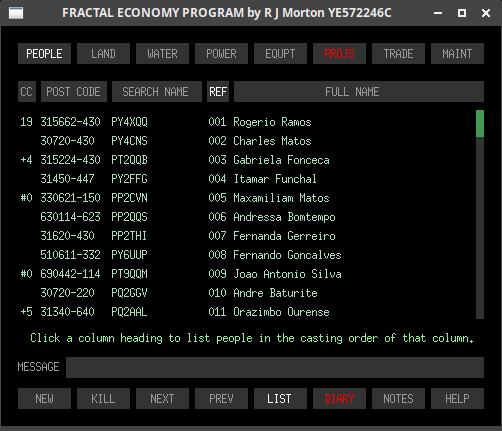
By default, people are listed in reference number order. However, clicking on one of the column titles causes the list to be displayed in the casting order of that column. This is another helpful way of finding somebody when you are not completely sure for whom you are searching. The list is scrolled using the mouse wheel, the up-down arrow keys or the Page-up/Page-down keys. Clicking the brightened LIST button takes you back to the normal single name and address display. The other bottom buttons don't function while the LIST button is bright.
Clicking the DIARY button causes it to become bright and all the diary entries currently on file are displayed as a scrollable list, as shown below.
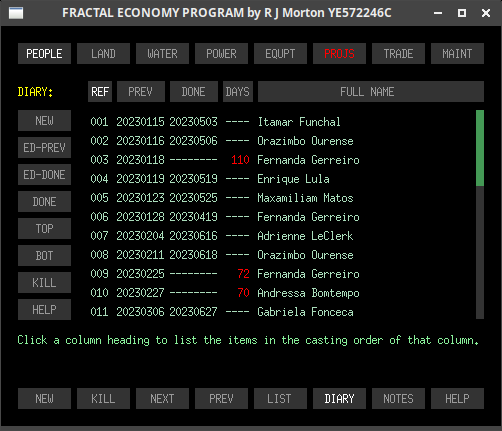
This is Leonado's DIARY. It contains events and their dates pertaining to everybody on file. When an event is entered, it will be with regard to the person whose name and address is currently displayed in the main name and address display. A provisional date is entered for the event. When the event has passed and has been attended to, the date it was attended to is entered in the DONE field and the DAYS column is marked with 4 dashes. If no DONE date has yet been entered, the number of days to go [shown in green] or the number of days late [shown in red] is displayed in the DAYS column.
By default, the list of events is displayed in reference number order. That is the order in which the events were entered into the DIARY. However, by clicking on a column heading, the list of events will be presented in the casting order of that column. For example, clicking on the DAYS heading causes the list of events to be listed in order of how many days remain before or have passed since the event.
If the number of days is in red, it means that Leonado is now late in attending to a prescribed DIARY event. In this case, when the bright DIARY button is clicked to leave the DIARY sub-tab, instead of reverting to grey, the DIARY button's annotation turns red. Furthermore, when Leonado exits the main PEOPLE tab, the PEOPLE tab button, instead of reverting to grey, also becomes red. This acts as an alert indicator that there is something within the PEOPLE tab that needs his urgent attention.
The NOTES button opens an ordinary text file that pertains to the person whose name and address is currently on screen when both the LIST and DIARY buttons are off. The file opens in the system's default text editor [such as gedit] and is stored in the '/notes' sub-directory directory. Here, Leonado can write whatever he wants in relation the the person concerned. To shut the file, simply close the text editor.
Clicking the HELP key causes the system's default browser of open this [Tab 0] section of this web page.
Tab 1: the LAND Tab
Every individual; that is, every user of this Fractal Economy Program, possesses, by right of birth, the right to the unencumbered allodial use of his fair share of the planet's habitable land, in order to live and turn his own labour directly into his own needs of life. The purpose of the LAND tab is to record details of this user's particular piece of the planet on which he was born.
The PLAN Sub-Tab
This shows a digitized plan view of Leonado's landshare. Its total area is about 10,000 square metres. In the example below, the landshare is circular. However it can be any shape that can be morphed easily from a circle, hexagon or octagon. The landshare's registration number and location [latitude and longitude of its mean centre] is shown, together with its height above sea level and its soil type and climate.
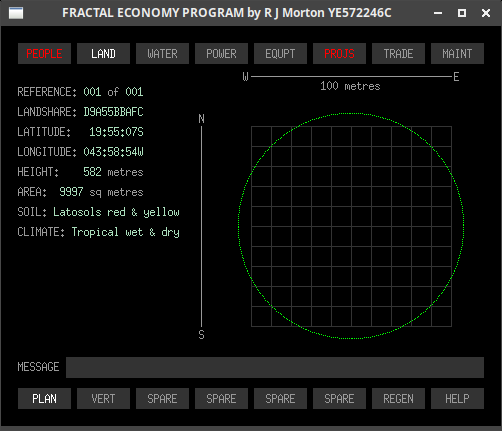
The landshare's boundary is plotted on a North-South/East-West grid. The true shape of the boundary of a physical landshare can be plotted manually from a map, digitized from a satellite image or surveyed physically using a 'total station' with reference to its central latitude and longitude.
The VERT Sub-Tab
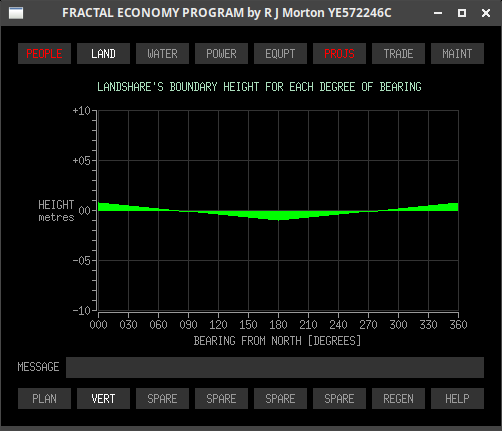
This sub-tab shows the height variation of the landshare above and below its median level. The other sub-tabs, whose buttons are marked 'SPARE' can be used for showing the various crop areas and natural forest areas into which the particular landshare is divided and also the use to which each crop area is currently put.
Tab 2: the WATER Tab
This tab deals with the means by which the landshare and its universal terrestrial dwelling unit acquire the water necessary for its occupants and crops. These means are rain, a water well, a lake, a stream or river, condensing water from the atmosphere, public mains water, recycled 'toilet-to-tap' water [which may require a bit of psychological adjustment on the part of the landshare's occupants].
The RAIN Sub-Tab
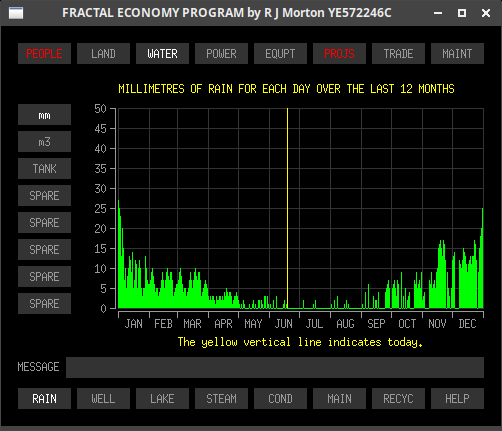
This is a real-time plot of the rainfall [in millimetres] on this particular landshare throughout the current year. The live graph shows the rainfall at a location in Minas Gerais, Brazil with a Tropical Wet-and-Dry climate.

Clicking on the 'm3' button, in the vertical column of buttons on the left, changes the display's vertical scale to show the rainfall in cubic metres.

Clicking on the 'TANK' button, in the vertical column of buttons on the left, creates a new display, showing the current amount of rain water stored in the tank and how full the tank is at the moment.
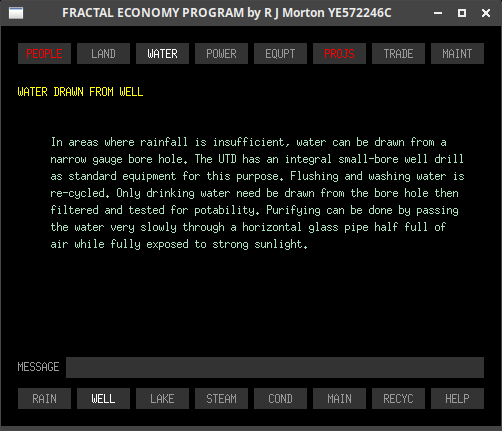
Clicking on the 'WELL' button, in the horizontal row of buttons at the bottom, would show data pertaining to the water extracted from the landshare's water well. However, this function has not been implemented in this demonstration version of the program.
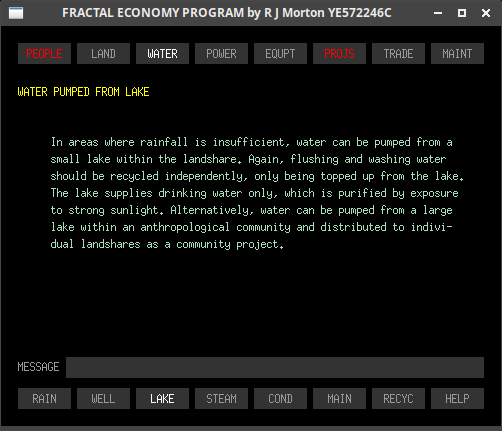
Clicking on the 'LAKE' button, in the horizontal row of buttons at the bottom, would show data pertaining to the water extracted from a lake either on the landshare itself or within its local community. However, this function has not been implemented in this demonstration version of the program.
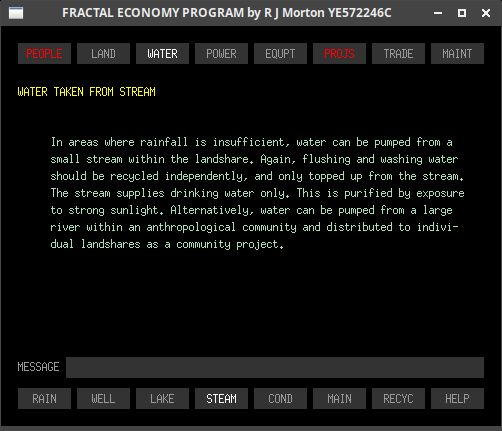
Clicking on the 'STREAM' button, in the horizontal row of buttons at the bottom, would show data pertaining to the water extracted from a stream on the landshare itself or a river that passes through its local community. However, this function has not been implemented in this demonstration version of the program.
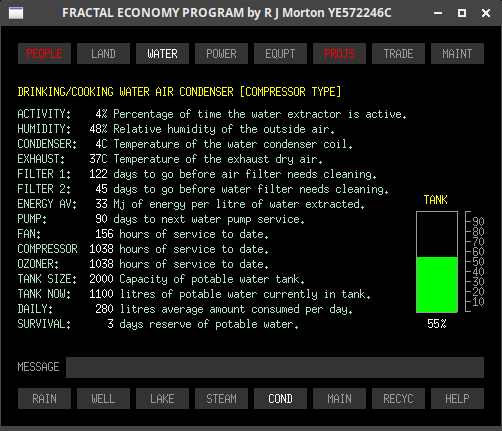
Clicking on the 'COND' button, in the horizontal row of buttons at the bottom, shows data pertaining to the water extracted from the air by condensation equipment within the UTD.
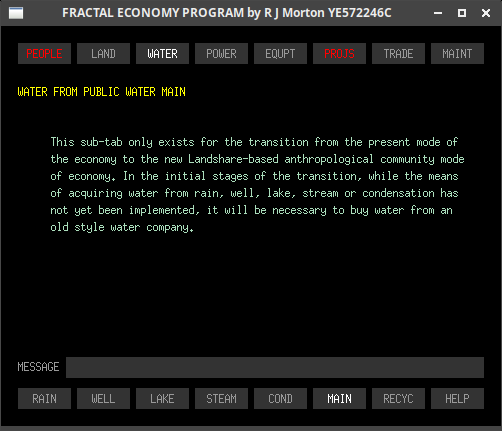
Clicking on the 'MAIN' button, in the horizontal row of buttons at the bottom, would show data pertaining to the water extracted from the municipal water main. This sub-tab is included because, at least in the initial transition phase from conventional houses to UTDs, the UTDs themselves will be dependent on a mains water supply. However, this function has not been implemented in this demonstration version of the program.

Clicking on the 'RECYCLE' button, in the horizontal row of buttons at the bottom, shows the data display pertaining to the water recycling system within the UTD. The display shows the more psychologically palatable version of water recycling. With this, only 'grey' water [used for washing and cleaning] is recycled: drinking water is always freshly extracted from the air. Notwithstanding, the ideal is to implement full 'toilet-to-tap' recycling. With this, all water is recycled, meaning that only water lost due to leakage and evaporation need be replenished from an external source.
Tab 3: the POWER Tab
The POWER tab deals with the diversity of power sources used to provide electricity for the UTD. These are solar cells, hidden built-in wind turbines, engine-powered auxiliary power units running on sustainable fuels such as ethanol or bio-mass [for emergency only]. There could also be community-based power sources such as hydro-electric generators in streams or rivers.
The SOURCE Sub-Tab

The power source sub-tab monitors how much of the UTD's current power is being generated from each energy source. The energy sources shown in red are unsustainable but may have to be used during an initial transition phase. The dark green source is what could be classed as semi-sustainable. The sources shown in green are fully sustainable.
The SOLAR Sub-Tab
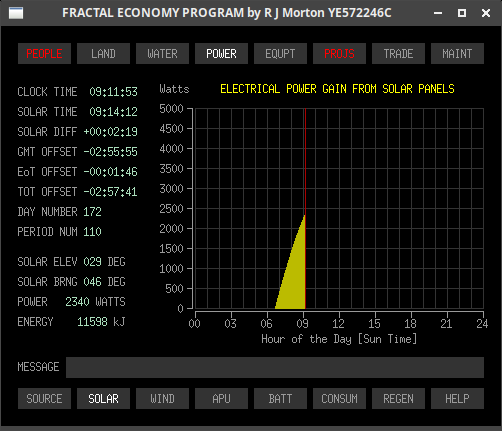
The UTD has a vast quantity of photovoltaic cells statically embedded behind the surface of its transleucent shell. However, this program also provides steering data for a gimbol-mounted array of photovoltaic cells that can be kept aimed at the sun throughout each day. The steering program is quite complex, having to account for the latitude and solar time off-set due to longitude, plus the further off-set due to an anomaly called the 'Equation of Time', which takes into account the Earth's orbital discrepancy throughout the year due to the eccentricity of the Earth's orbit and the non-homogeneity of the solar mass.
The WIND Sub-Tab
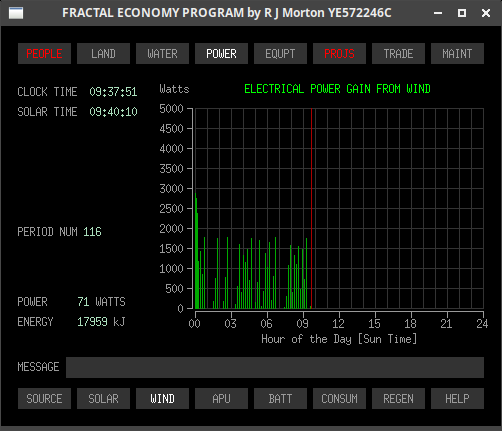
The shell of the UTD has wind doors in each of its 4 sides. These can be opened and shut according to current wind conditions in order to channel the prevailing wind through internal turbine enclosures to generate electricity for the UTD.
The APU Sub-Tab
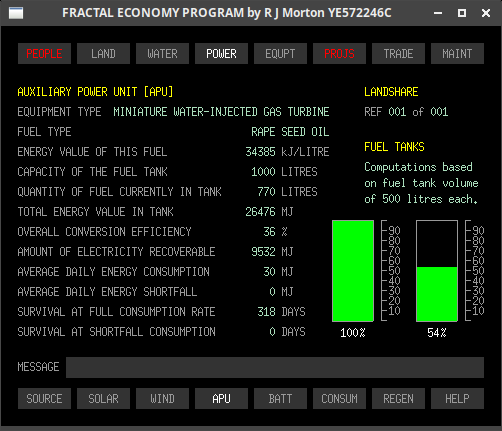
The auxiliary power unit is for supplying power for the UTD when, for whatever reason, none of the fully sustainable methods is operational. In the early phases of implementing UTDs, a diesel engine would probably have to be used. However, this would be replaced as soon as possible by a less-polluting engine such as a rape-oil fuelled water-injected gas turbine. Two fuel tanks are provided and perhaps the engine-generator unit itself should be duplicated to allow user maintenance to be conducted on one unit while the other unit is operational.
The BATTery Sub-Tab

The UTD has two separate power supply circuits or busses like an aircraft. Either bus can supply the whole of the UTD's power needs in the case where one of the busses fails or is under maintenance. Each bus is supplied from its own battery. Both batteries are charged independently from the various power sources described above. The UTD's lighting would be well covered by a 4-D 180ah deep-cycle battery. This would supply 180 x 12 x 0·8 = 1728 watt-hours, Say 1730. This will light 70 5-watt LED bulbs for 5 hours. The UTD has 4 lamps per hexagon + 2 per square. That is 5 x 4 + 2 x 4 = 28 5-watt lamps. This leaves 42 × 5 = 210 watts to supply other electrical equipment, which should be more than adequate.
I have chosen to specify lead-acid batteries for the UTD. These are the least polluting in both the short and long term and are user-maintainable. Other exotic battery technologies, which can store electricity at much higher energy densities, is likely to create a serious chemical disposal and recycling problem in the long term.
A lead-acid battery has a mean energy density of 0·3 megajoules per litre. It is sensible to maintain a reserve of one day's electrical energy consumption, which is 30 megajoules. This will require a battery of total cell capacity 30÷0.3 = 100 litres. For a 12 volt battery of 6 cells, each cell must therefore have a capacity of 17 litres. It is also expedient to use a battery that is user maintainable. This way, after every 365 charge/discharge cycles, the user is able to dissemble each cell of the battery, pour its acid into a temporary container, clean the cell jar, scour the copper and lead electrodes and reassemble the cell again. Each 17 litre cell should therefore be constructed as a cylinder made of tough glass with a tight fitting ground glass lid to which the electrodes are secured. A reasonable proportion for the cylinder would be 20 centimetres diameter by 60 centimetres high.
The CONSUMtion Sub-Tab
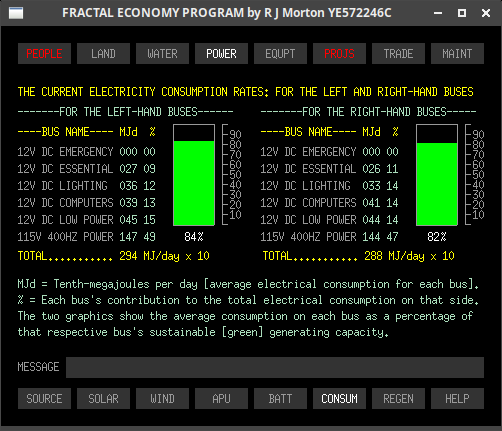
The electrical consumption tab shows the on-going mean average consumption of electrical energy per day [in megajoules] for each of the duplicated [right and left] busses of the UTD's electrical system.
The REGEN button does not have an associated tab display. Clicking on it merely regenerates the POWER tab's data for use in the case where data corruption within the system has occurred or is suspected.
Tab 4: The Equipment Tab
This tab is for managing the operation, configuration and maintenance of the various kinds of active equipment used on a landshare. It includes the active equipment within the UTD itself, the mobile robotic equipment that works the farm and the small-area navigation system that guides the robotic farm machinery.
This tab does not include the global navigation system used by the UTD itself when moving from its current landshare to a new location or the UTD's global communications system. These are covered respectively by the separate programs nav.c [described here] and com.c [described here].
Only 3 of the EQUPT tab's 7 possible sub-tabs have been populated so far and they are only partially implemented. That is, the vertical selector buttons work in that they indicate their current states when clicked. However, there is as yet no functionality behind them. This tab is thus simply for the illustration of future intent. The following tab images should be self-explanatory.
The UTD Sub-Tab
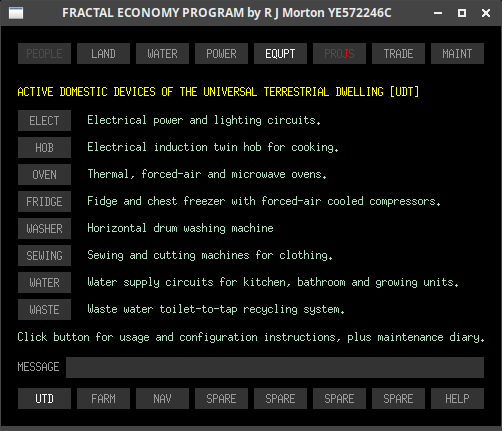
The FARM Sub-Tab
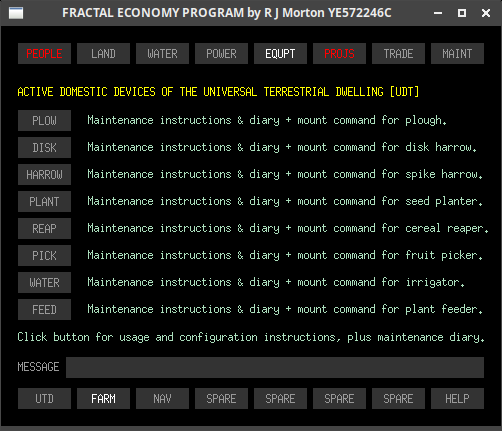
The NAV Sub-Tab
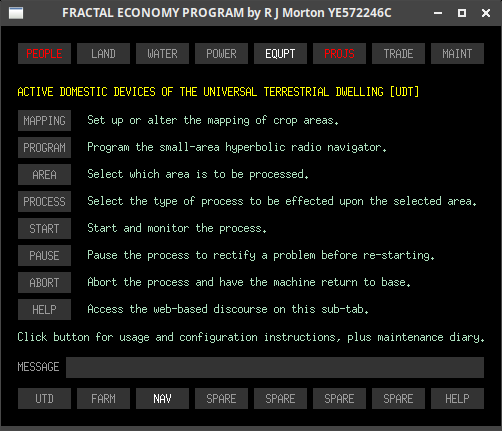
Tab 5: The Projects Tab
This tab is for managing the various types of projects that take place in the UTD and the landshare within which it is located. These projects can include growing crops, raising animals, fabrication of goods [such as furniture, components, machinery and even UTD parts], scientific research, engineering development, plust craft work and objects of art.
The CROPS Sub-Tab
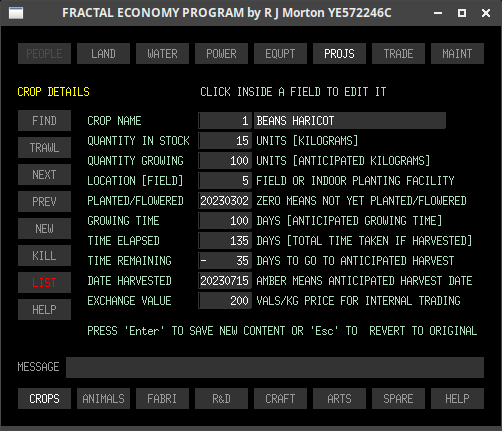
The crops sub-tab displays the quantified data pertaining to a single crop. The data items are self-explanatory except to note that the 'Exchange Value' on the last line refers to a value per unit weight by which dissimilar crops are exchanged with other landshares. It is a non-inflating, non-interest-bearing currency used only for crops.
The buttons in the vertical column on the left work as follows. The FIND button boxes the first data field. Here you can enter a crop REFerence number. When you press the 'Enter' key, the program displays the details of the appropriate crop. Clicking the TRAWL button boxes the crop name field. You can enter all or part of a crop name here, press 'Enter' and the program will display data for the nearest match to the crop name you entered. The NEXT and PREV buttons display the next or previous crop records in reference number order. However, if the last crop was found by trawling for its name, clicking the NEXT button causes the trawl to continue for the next occurrence of the crop name. Clicking the NEW button clears the data fields ready for entering the data for a new crop. Clicking the KILL button causes the data for the currently displayed crop to be deleted. Clicking the LIST button causes the display to be replaced by a crop list as shown below.

The crop list is a scrollable display of data listing all the crops grown on the landshare concerned. The list shows the date the crop was planted, the date it was harvested, the number of days to go before harvest [assuming it has not been harvested yet], the location of the crop [the field number], the REFerence number of the crop type and the name of the crop. The list can be scrolled up or down using the mouse wheel, the up/down arrow keys or the page-up/page-down keys.
By default, the crops are listed in order of crop REFerence number. However, by clicking on any column heading, the list is re-displayed in the casting order of the clicked column heading.
Clicking on the brightened LIST button returns you to the single-crop data display. None of the other buttons, in the vertical column of buttons on the left, is active while the LIST button is bright.
By clicking on any line within the list, you thereby select that line, which then becomes highlighted. Having done this, if you now return to the single-crop data display, you will see the data for the crop whose line you selected in the LIST.
The Other Sub-Tabs

All the other PROJS sub-tabs are of the same form and function as the CROPS sub-tab. Only the annotations and data types differ. Consequently they are not implemented in this demonstration version of the program.
Tab 6: The Trade Tab
This tab helps manage the exchange of goods between landshares and also with the outside world.
The CONSU Sub-Tab
The CONSU sub-tab helps the landsharer to manage the exchange of consumable goods with other landsharers. The guiding rule is that only the minimum necessary and sufficient consumable goods, such as food and fuel, should be traded: that is, exchanged between landshares in return for a prescribed value, per unit weight or volume.
This value has the form of a universal currency, which I have called the 'Val' [unit of Value]. A Val has the function of an IOU [I owe you] note issued by the buyer. It cannot be lent and therefore does not inflate or attract interest. There is an upper limit on the number of Vals a landsharer can issue. This is a prescribed percentage [less than 50%] of the value of residual stock of consumables that he possesses.
A landsharer must always be left with sufficient consumables to physically survive. Wherever and whenever this condition cannot be met, it is the duty of the landsharer's community to meet his survival needs in full.
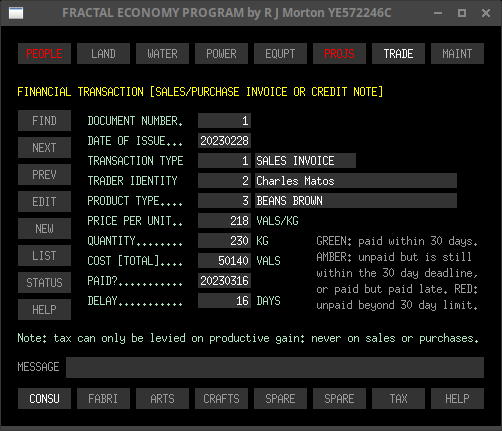
The details of each transaction of exchange are recorded in a transaction record as illustrated above. The various fields of data are self-explanatory. Such transactions cannot be part of a system in which tax is extracted by a non-producing entity such as a local authority or state, since this would necessarily cause the Val to inflate. If a landshare community has to be constructed within a limited liability container within a capitalist economy, a separate tax-bearing accounting system, using the state's inflation-prone currency, must be constructed in one of the SPARE sub-tabs.
Clicking the FIND button, in the vertical column of buttons on the left, boxes the top data field. This allows a transaction number to be entered. Then, on pressing the 'Return' key, the details of the transaction concerned are found and displayed. The NEXT and PREV keys display the details of the next or previous transaction in order of transaction number. Clicking on the EDIT button and then clicking on one of the data fields boxes the field concerned and allows it to be edited. Press the 'Return' key to store the edited data or the 'Esc' key to revert to the original field content. Clicking the NEW button causes all the data fields to be cleared for entering a new transaction.
Clicking on the LIST button causes a scrollable list of all transactions currently on file to be displayed, as shown below.

The list shows the transaction number, the date of the transaction, the name or reference of the person with whom the transaction was struck, the name of the type of consumable being traded, its price per unit weight or volume, the quantity of the consumable that was exchanged, the total value exchanged and how many days have elapsed since the transaction was struck.
If the number of days appears in white, the payment has been made. If it is shown in green, the payment is not yet due. If it is shown in red, the payment is overdue by the number of days shown.
The list can be scrolled up or down using the mouse wheel, the up/down arrow keys or the page-up/page-down keys.
Clicking on the bright LIST button causes a return to the single transaction display. Clicking on the STATUS button causes the status data to be displayed as shown below. The other vertical buttons are inactive while either the LIST or STATUS button is bright.

The CONSU accounting sub-tab operates on an annual basis. It has an imposed limit of 255 transactions per year [sales + purchases]. This is to develop an ethos of minimising the amount of trade between landshares. In other words, with its incisively programmed robotic machinery, a landshare is able to produce the quantity and variety of consumables needed by its occupants, irrespective of the farming knowledge or lack of it. Trading of consumables between landshares is therefore essentially for exceptional situations of drought or catastrophe in which crops fail or for where the land does not support the production of certain essentials.
The remaining sub-tabs are not implemented in this demonstration version of the program but they contain very much the same form and functionality as the CONSU sub-tab.
The FABRI Sub-Tab
In the present socio-economic order, everything produced is regarded as a consumer item: something that is consumed on an on-going basis. For example, a washing machine is regarded as a consumer item. As a user, I want my washing machine to provide service to me for as long as possible. I thus require that I should only need to replace parts or components that are expendable in the true engineering sense. These are such things as drive belts and motor brushes. I do not want to have to throw the whole machine away if it stops working.
On the other hand, as a capitalist producer, I want the washing machine I produce to become unusable as soon as possible after I have sold it so that the consumer is forced to buy another one as frequently as possible so that I thereby make more profit. I must tread a fine line to make it become dysfunctional as soon as possible after the end of its statutory guarantee period. I must also design it to be as difficult as possible for the user to repair or service it.
The capitalist producer, being the stronger party, naturally gets his way. Twenty years ago, I bought a washing machine from a little known manufacturer. It is still working perfectly. Its belts are still good. Its motor brushes are still good. There is absolutely no play in the main drum bearing. This manufacturer is no longer in business. The ones who are still in business and thriving are the ones who make attractively designed washing machines with short life-spans.
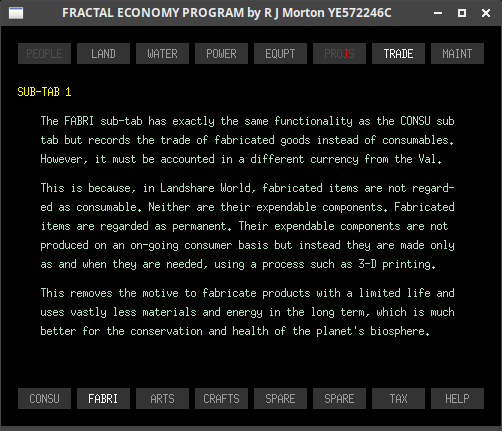
For fabricated items, the motive to continuously produce in order to stay solvent must be removed. This is why, in Landshare World, fabricated items such as accommodations, furniture, machines and utensils are not valued in the same currency as consumable products like food. Expendable components must be 3-D printable to order either by the user himself or by one of his community neighbours. The FABRI sub-tab shown above is therefore implemented in the same way as the CONSU sub-tab except to cater for fabricated items.
The ARTS Sub-Tab
As part of a diversity of activities, landshare dwellers may choose to engage in the creation of works of art of various kinds. The ARTS sub-tab works in much the same way as the other TRADE sub-tabs and is used to record the details of a work of art and to whom it was sold or given.
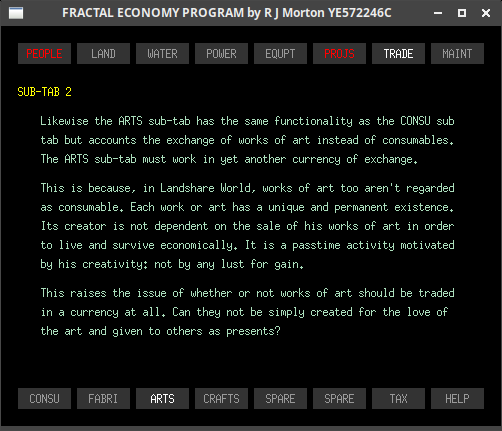
Thus, a work of art has no essential economic function. It is there simply to express or represent an uplifting feeling, principle or emotion.
The CRAFTS Sub-Tab
I think of crafts as the artisanal work of producing useful items that are individually tailored to the needs and dimensions of each individual recipient.
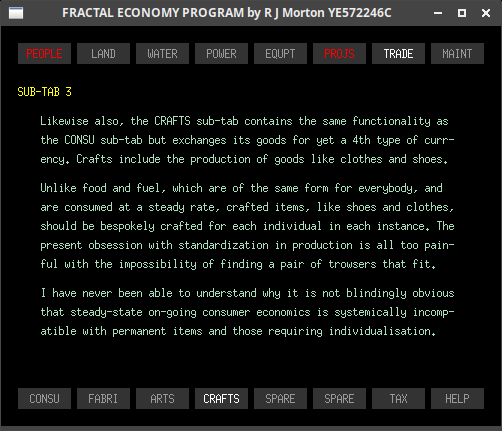
Such items may be bought and sold or simply given. The CRAFTS sub-tab enables the landsharer to monitor and record what was crafted, given or received, and to or from whom.
The SPARE Sub-Tabs
All the foregoing forms of production, supply and receipt — whether or not they be transacted in exchange for Vals, or one of the other currencies mentioned — take place within the confines of a private corporate container. Each landsharer is a participant in such an entity comprising his coterie of partners. Consequently, all transactions are internal to the entity concerned.

Notwithstanding, while landshare communities are forced to reside within a present-day sovereign jurisdiction, it will be necessary for them to interact legally within that sovereign jurisdiction. Consequently, each will need to account such interactions in terms of the tax-attracting inflation-prone currency of the sovereign entity in which he is located.
Two SPARE sub-tabs, of the form illustrated above, are available for implementing an accounting system that conforms to the particular mode of operation of the sovereign jurisdiction in which the landsharer is currently located.
Tab 7: The Maintenance Tab
The MAINTenance tab contains the functionality needed to perform various housekeeping tasks to keep the user's data secure and to recover its integrity if it should become corrupted.
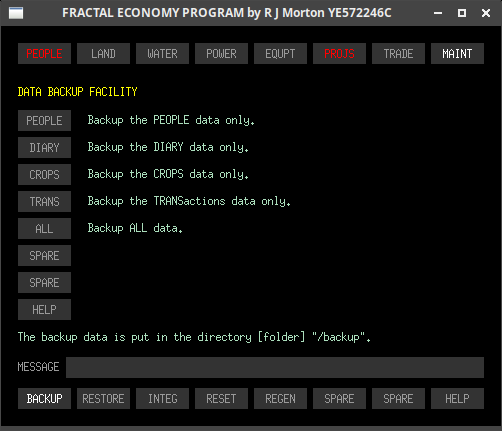
The BACKUP sub-tab enables the user to make a backup of all or part of the data maintained by the program. Clicking on one of the buttons in the vertical column of buttons on the left causes the type of data described on its right to be copied into a separate '/backup' folder [directory].

The RESTORE sub-tab enables the user to copy data from the '/backup' folder back to the equivalent folder in the program's data. make a backup of all or part of the data maintained by the program. Clicking on one of the buttons in the vertical column of buttons on the left determines which type of data will be restored to the program from the '/backup' folder [directory].
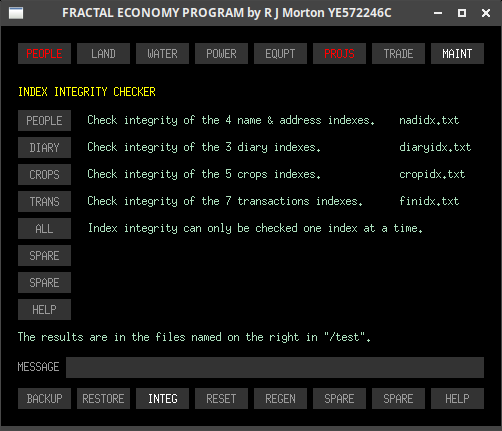
The INTEGrity sub-tab enables the user to check the integrity of the indexes associated with any one or all of the 4 types of data maintained by the program. Clicking on one of the buttons in the vertical column of buttons on the left determines which type of data will be subject to the index integrity check. The result of an integrity check is displayed as a message within the message field at the bottom, with a full analysis being given in appropriately named files in the '/test' folder [directory].
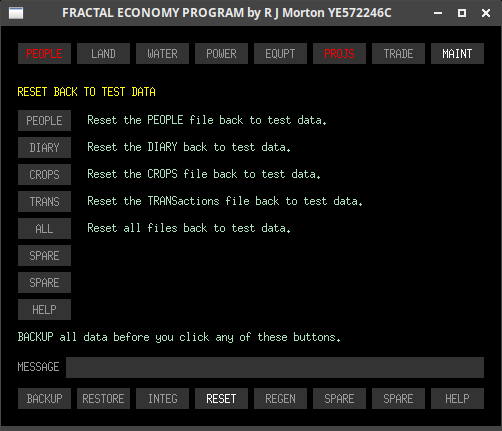
The RESET sub-tab enables the user to reset all or part of the program's data to the test data. If you need to revert to your live data at some later date, you need to BACK it UP before clicking any of the buttons in the vertical column of buttons of this sub-tab.
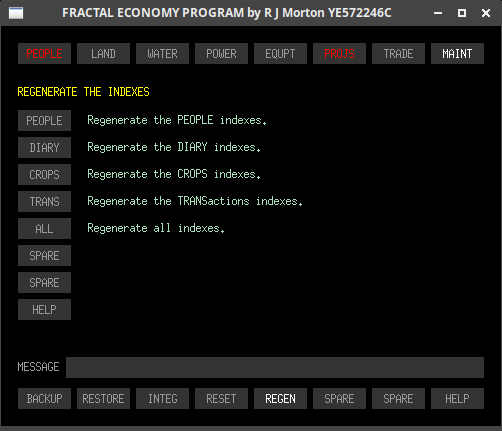
Power failures, voltage spikes, hardware faults and other causes can result in loss or corruption of data. In cases where a main data file survives intact, it is possible to reconstruct all associated indexes from data in a main file. The REGEN tab enables the user to expedite this index reconstruction from one or all of the main data files by clicking on the appropriate button in the vertical column of buttons on this tab.
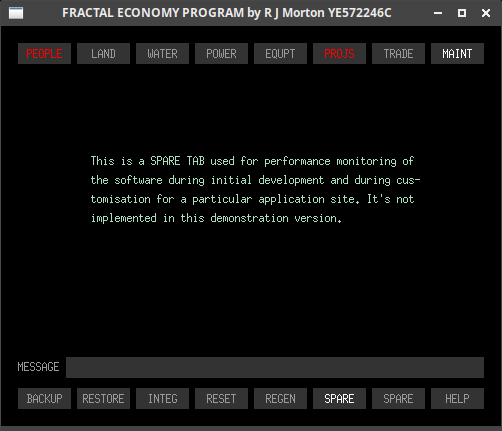
The two SPARE sub-tabs are for possible additional maintenance functions, which could be implemented in the future.
NEXT PREV ©June/July 2022 Robert John Morton







































